Dee Estuary Birding
Monthly Newsletter...
May 2024
Newsletter
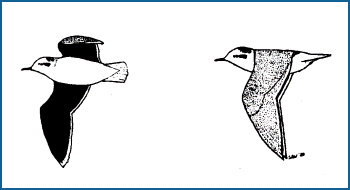
Species Spotlight - Little Gull
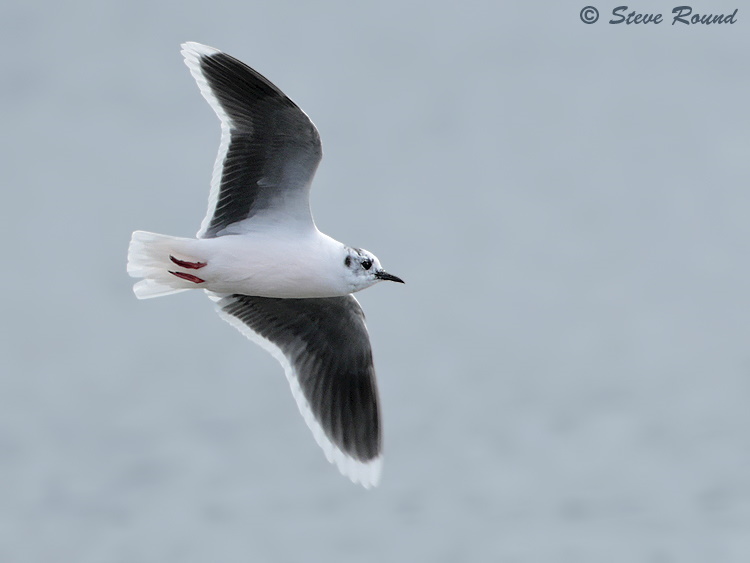
"Movements and records of this species continue to be bewildering in terms of trying to establish a regular pattern." Cheshire Bird Report 1976.
"The erratic occurrence
of the Little Gull makes it
difficult to judge its true status, abundance and any rate of
change" and "The transient and ephemeral nature of the Little Gull
makes it difficult to judge its conservation status." The Birds of Wales (2021).
Little Gull - an intriguing species and I picked out
the two quotes above, 45 years apart, to demonstrate that there is an
awful lot we don't know about them. They spend the winter mostly out of
sight from land so we have little idea exactly where they are or
how many, and they breed around remote lakes in Scandinavia and east to
Siberia where they are difficult to monitor. As you will read below,
when they are on migration they are much easier to see but even then
they are subject to abrupt changes of routes and numbers. We are
lucky here on the edge of Liverpool Bay where for the past forty years
they are routinely seen
on spring migration. Although numbers have dropped from what they were
in the first decade of this century Liverpool Bay remains one of the
the best
places in the UK to see Little Gulls on spring passage and there were
86
off North Wirral this last spring on the early date of March 5th 2024,
which is
the highest number we've had here since 2016.
History of Little Gulls
In the Birds of Cheshire (Ref
1) T. Hedley Bell says that they were known as winter rarities going
back to the 19th century, and far less than annual, but by the time he
wrote his Supplement
(Ref 2), in 1965, they were more often seen in summer and autumn
although still mostly just single birds. But there was a hint of an
increase in numbers with a report of the largest party so far recorded
in Cheshire/Wirral with nine off New Brighton in September 1965.
"The status of the
Little Gull Larus minutus in Liverpool Bay has changed dramatically
since 1965"
(Ref 3). So wrote Ray Eades, who some of you will remember, in 1982.
From 1963 to 1976 Ray counted Little Gulls almost on a daily basis
whilst working as a Pilot and I can do no better than to illustrate the
dramatic change he saw by reproducing the table in the article he wrote
for
the 1977-1981 Seabird Report.
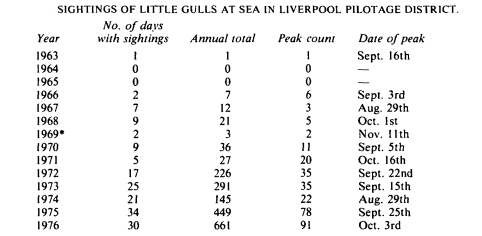
From none at all in 1964 and 1965 numbers increased
just eleven years later to 661 in 1976. Two things I noted in the
article was that, (1 ) all but 5% of records were in summer and autumn,
and (2) nearly all the Little Gulls were in the Crosby/Formby Channel
(i.e.
in the Channel between Formby Point and Seaforth), with very few in the
area between the Bar Lightship and Point Lynas on the north-east coast
of
Anglesey.
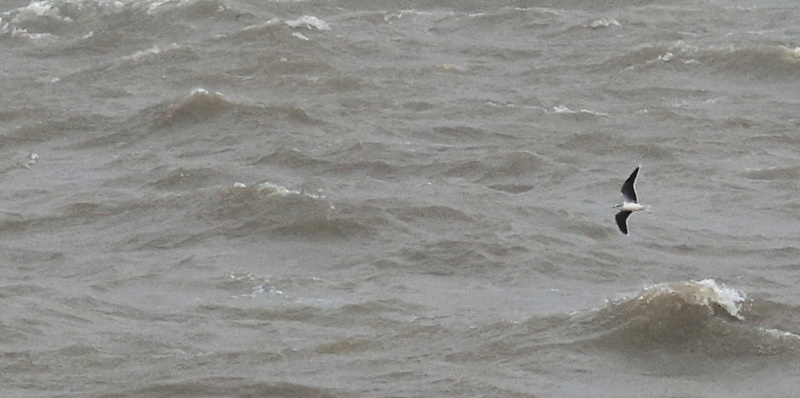
J.D. Craggs writes in the Hilbre book (Ref 4)
summarising records gathered by the Hilbre bird Observatory between
1957 and 1977: Records
have increased in frequency from 1970 before which we had only 2.
Numbers are extremely variable and the peak was reached in December
1975 when 135 were seen on the 7th and 128 on the 21st - no doubt the
same flock. At that time numbers in spring were very low,
something which was soon about to change.
It wasn't just Liverpool Bay where numbers of
Little Gulls increased dramatically, similar increases were being seen
right across the country as detailed by Hutchinson and Neath in their
British Birds article (Ref 5). I reproduce their bar chart for
Lancashire, Cheshire and Flintshire which is a summary of land based
records going all the way back to 1934, and it shows a similar pattern
to Ray Eades' ship based records. Hutchinson and Neath published very
similar bar charts for the rest of the UK, with the exception of the
west coat of Scotland where they have always been rare.

What caused this massive increase in the late
1960s and early 1970s and beyond isn't clear. There is evidence for a
western expansion of the breeding range into Finland with BWP (Ref 6)
stating that they had increased from 200 pairs in 1958 to over 1,000
pairs by 1980 - although the numbers all seem a bit vague. Since then
expansion has continued with a north western movement of their breeding
range with less breeding in the countries bordering the south-east
shore of the Baltic and more in Sweden and Norway, as shown when
comparing the first European Breeding Bird Atlas (1980s) with the
second (2013-17) (Ref 7). Finland, and further east into Russia, still
remains the most important breeding areas. With the current European
population estimated at 23,700-45,200 pairs,
which equates to 47,400-90,500 mature individuals (BirdLife
International 2015 Ref 8), that estimate of 'over 1,000 pairs' in
Finland is surely a big underestimation, even if it's technically true.
But all this doesn't explain
the sudden increase in the UK in just 10 years, so it seems likely that
there must have been changes in migration routes and wintering areas to
go along with the range expansion, probably they found good sources of
food in the Irish and North seas, and further south.
Liverpool Bay - A big increase in spring
Whilst the majority of Little Gull records for the country in the 1970s were, and still are, in late summer and autumn - that was about to change in Liverpool Bay. There were signs of increasing numbers in spring with 30 off Red Rocks on March 27th 1977, 53 off Hilbre on March 9th 1979 and 205 off Meols on April 4th 1982. On the Sefton coast the Little Gulls were being monitored by Philip H. Smith with frequent visits between January 1975 and December 1984. Using these, and earlier observations, Smith wrote in Ref 9 that between the years of 1969 and 1974 1.1% of the Little Gulls recorded were present in April and 58.7% in August/September. In contrast, between 1975 and 1984 51.7% were seen in April and 25.4% in August/September. A remarkable turnaround.
For the next 30 years Liverpool Bay became the Little Gull capital of Britain! Here's a couple of bar charts to illustrate numbers.
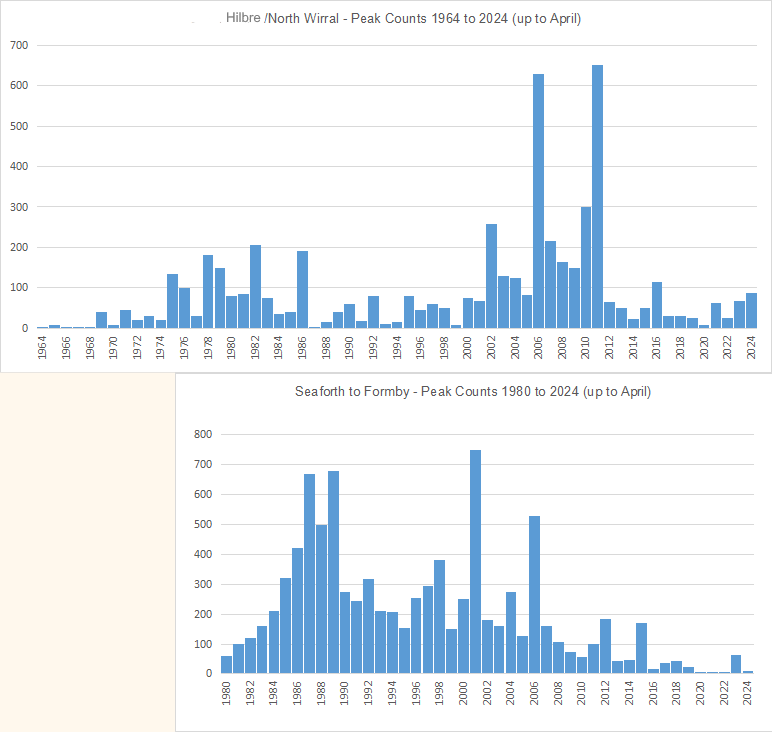
The first counts of over 100 off Hilbre came in 1975
when a flock of up to 135 was seen several times over November and
December that year. Most peak counts prior to 1980 were in summer
or autumn, but after 1980 they were all in March or April.
At
Seaforth/Formby all peak counts between 1980 to 2024 came in April.
However, numbers have plummeted at Seaforth over the past ten years and
reached a low point in 2022 with a max count of just three. Indeed,
that was the highest count anywhere in Lancashire and North Merseyside
for the whole of that year! Thankfully there have been higher counts
since with a maximum at Seaforth of 10 in April 2023 and 11 in April
2024, and good numbers elsewhere including 187 past Heysham on April
20th 2023.
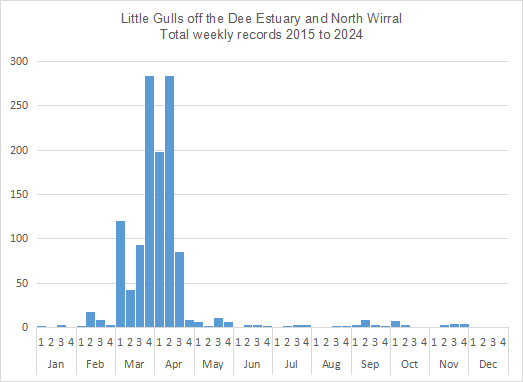
The bar chart above shows the weekly distribution
for Little Gulls off the Dee Estuary and North Wirral for the past 10
years (2015 to 2024). You can
clearly see how the large majority of records are between the first
week
of March and the third week of April, whereas the return passage, in
September and early October, is virtually non-existent
in comparison.
The usual pattern of spring arrival is that Little
Gulls are
first seen off Hilbre and North Wirral in late February or during
March. Here
they are often recorded dip feeding and occasionally roosting on sand
banks with West Hoyle Bank a favourite spot. Most years they will
only be recorded on a few days with, typically, numbers varying from
around 10 up to 60 or more. They appear to use Liverpool Bay as a
staging post in March and they are also often seen off Formby at this
time, with probably larger numbers further out. Sadly, the gathering in
April and early May of hundreds of Little Gulls at Crosby Marine Lake
and Seaforth, where they fed on non-biting midges (Chironomid),
no longer takes place with the last big count being on May 2nd 2012
with 183. The high count of 172 in April 2015, was off Formby.
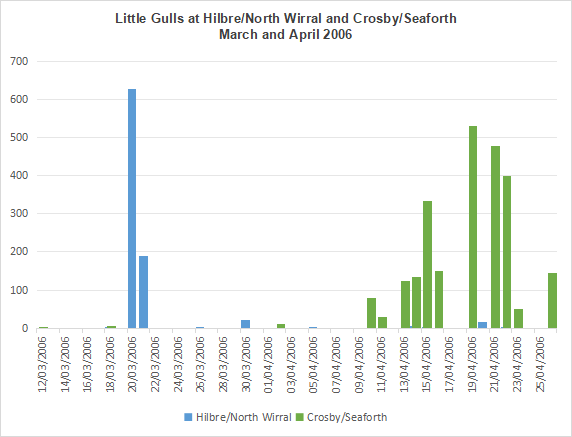
There have been two very big counts at Hilbre this century - one in 2006 and the other in 2011. The bar chart above, for 2006, shows nicely the transient nature of this species as recorded from Hilbre with just two days of three-figure counts, compared to Crosby Marine Lake and Seaforth where they were present in good numbers throughout April.
Chris Felton was the lucky observer on Hilbre on
March 20th 2006 and he wrote an article about his experience which was
published in both the Hilbre and the Cheshire & Wirral Bird
Reports for 2006. I loved his description of the Little Gull flocks and
here is
a short extract (there was a brisk easterly wind blowing which the
birds were flying into):
"I caught sight of a
flock of Little Gulls Larus minutus, making
it's way towards me from across the mouth of the Dee. Eventually, 111
came along, strung out low over the water, rising and dipping,
butterfly-like, as they passed, the black underwings clearly
noticeable. As Some birds landed briefly on the water, those behind
leap-frogged over them causing them to take flight and hastily catch
up."
In all Chris saw around eight distinct groups mostly of around 60 birds, and with clear gaps in between each flock. The total was 628, and, at the time, the highest ever March count for Liverpool Bay.
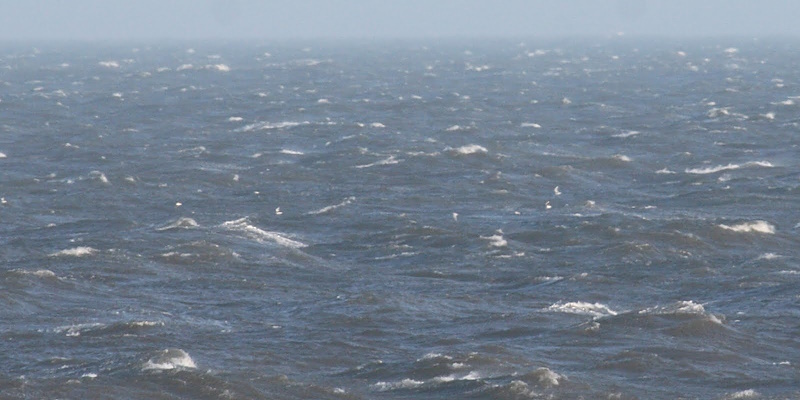
An even higher count came on March 31st 2011, as
described in the Hilbre Bird Observatory Blog for that day:
"After overnight rain a west south westerly blew up to force 6/7 and then gale force 8 by 08:00hrs. With obviously not much action to be expected on the migration front, sea watching was the main attraction this morning. Right from the off flocks of Little Gulls were seen moving west in a narrow band in the medium distance (above, the sort of view one might see through binoculars!), in large groups at first and then thinning out later in the morning. The end of the session total came to 651 birds, a record count for Hilbre."
Where do they spend the winter?
We don't know for sure where these Little Gulls spend the winter but both Smith, writing in 1987, (Ref 9) and Messenger, writing in 1993 (Ref 10), concluded that it was very likely that many of the Little Gulls we see in Liverpool Bay in spring had spent the winter in the Irish Sea. An examination of recent records up to the present time suggests they still do.
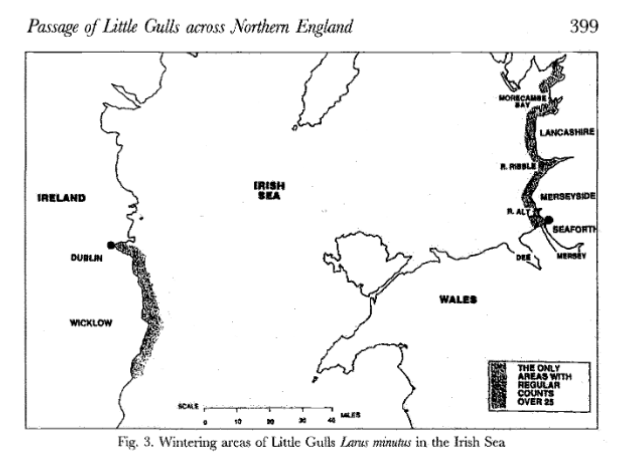
I've shown the map, above, which was published in Ref 10 in 1993 because the exact same map could be drawn today. The shaded areas show 'The only area with regular counts over 25' - and that applies to the whole of the Irish Sea, not just the portion shown. It took Messenger a lot of work to find and collate all the data but these days we have BirdGuides and I was able to look at all records from around the Irish Sea for December and January since the turn of the century and, for those two months, I found 14 counts of over 25 in the area just south of Dublin and along the Wicklow coastline (max 155 in 2013), and 21 counts of over 25 between the south coast of Morecambe Bay to Seaforth (max 195 in 2005). Messenger said "Little Gulls usually begin to arrive on these coasts immediately the winds exceed force 3 and, as they increase in severity, so more gulls arrive", the fact that the flocks appear so soon after the onset of fresh on-shore winds must mean the birds are not far from the coastline. I've not found any other records of flocks of over 25 elsewhere in the Irish Sea for December and January this century.
As well as the BirdGuides data,
aerial surveys were carried out over Liverpool Bay during the winters
of 2004/05, 2005/06 and
2010/11 which specifically looked for Little
Gulls. They came up with a figure of 333 based on the mean peak over
those three winters (Ref 11). Most of the Little Gulls were around 12
miles out off Blackpool, and the figure of 333 was thought to be an
underestimate.
How much Little Gulls move between these two main areas in the Irish Sea is a complete unkown. If they are moving across the Irish Sea in winter they are doing so out of sight of land as records from North Wales including Anglesey and Bardsey Island, and the Isle of Man are just of a handful of of one or two birds. It's strange that westerly gales don't result in flocks of Little Gulls from the east coast of Ireland ending up on the Welsh coast, but it doesn't appear to be the case.
A lot of Little Gulls winter further south around
the European coastline and, as suggested in the next
section, it seems likely that some of these make their way up the Irish
Sea in spring on their way to the breeding grounds.
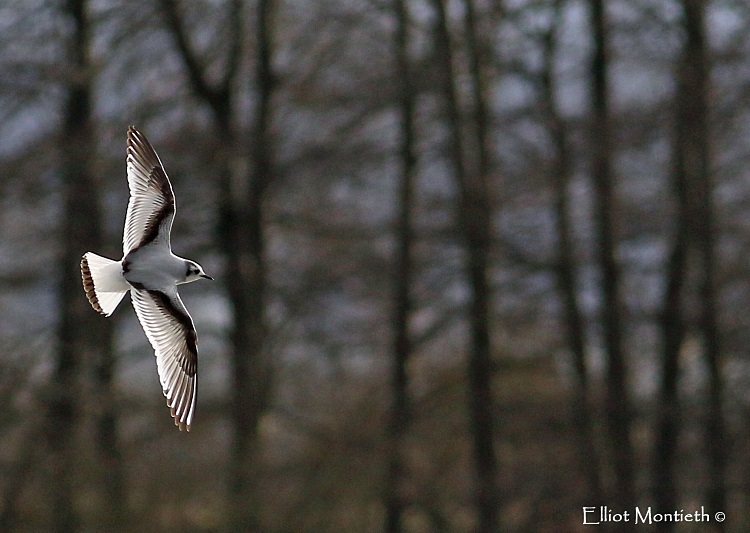
The Spring Passage
Little Gulls arrive in Liverpool Bay in spring with the first ones recorded in March, they appear to spend a few weeks here before heading across the country in April on their way to Finland and nearby countries to breed. In some years there is also an obvious movement further south with birds making their way up the Severn Estuary in April and then heading north-east across the country. But until they hit the coast their movements into, and in the Irish Sea are unknown as they always stay out of sight of land. A lot of Little Gulls over-winter off the south-east coast of Ireland and must cross the Irish Sea by going round to the north of Anglesey yet records from there are almost non-existent. The same applies to any Little Gulls coming into the Irish Sea from further south, these must end up either going into the Bristol Channel or further north to Liverpool Bay - but again, records from the west coast of Cornwall, the Scilly Isles, Pembrokeshire, Bardsey Island and Anglesey are very sparse indeed. I find it fascinating that this species will, at times, quite happily roost and feed, sometimes in their hundreds, on the coast and inland waters, yet on passage they stay resolutely at least 10 miles out to sea!
The spring passage in 2023 and 2024 were very different from each other, so I thought it would be interesting to go into some detail.
In 2023 the peak of the Little Gull passage took
place over three days, from April 19th to 21st. The
map below tells the story with several hundred moving up the Severn
Estuary
and heading north-east whereas others reached Liverpool Bay and
Morecambe Bay before flying east, all within this three day period. To
give an idea of numbers a few
sites are marked with the max daily count, and
many sites posted record numbers, for example 67 were at Woolston Eyes,
the previous
highest count was just nine. The 187 which flew past Heysham in three
flocks was the highest count this century and both the 217 at Severn
Beach, Gloucestershire, and the 59 over Chasewater Reservoir in
Staffordshire were record high counts.

There were several sightings of Little Gulls off Leasowe in late February and early March 2024 peaking at 86 on March 5th, the highest count for the British Isles for that month. There was another flurry of records at the end of March including 16 seen from Hilbre on the 30th, indicating that Little Gulls were still out there in Liverpool Bay. 10, at Seaforth on April 5th, may well have been the same birds.
There was one other site in the country which had
good numbers in early April - that was at Monikie CP, just a few miles
north-east of Dundee, with a remarkable 220 Little Gulls on April 1st.
There were none reported from here in April 2023 but the Firth of Tay
area has long been associated with Little Gulls going right back to the
1950s when they were a rarity eleswhere in the country (Ref 5).
But once we got past the first week of April numbers
in the UK were very low. 15 spotted at Staines Reservoir, London, on
the 27th hinted at a passage across the south-east but elsewhere nearly
all records were of just one or two birds. The map shows the records
for the whole of the second half of April 2024 when we would normally
expect Spring passage to peak, quite a contrast with 2023!

Ringing
Thanks to ringing the evidence that the Little Gulls we see on spring passage end up breeding in Finland and nearby countries is strong. A total of 16 Little Gulls ringed at Seaforth have been found elsewhere including several in Finland and one well into Russia, in the Arkhangelsk Oblast 2,759Km from Seaforth (Refs 12 and 13).
Huge numbers at Hornsea Mere and the East
Yorkshire Coast
Although on the other side of the country from the
Dee Estuary, I can't finish this article without mentioning Hornsea
Mere and the adjacent Yorkshire coast as it's a classic example of very
big numbers of Little Gulls appearing in an area where they were
virtually unknown before. I start with an article in British Birds 'Little Gulls at sea off Yorkshire in
autumn 2003'
by Clive Hartley (Ref 14). During a ship-based survey on 11th-12th
September 2003 off the Yorkshire coast, between Flamborough Head and
Spurn Point, he came across large numbers of Little Gulls and
Kittiwakes feeding about 12 miles out from the coast - the number of
Little Gulls far surpassed all previous records. They were seen
"feeding... often in a frenzy of activity with other seabird species"
and he noted "these flocks took the form of dense clusters, containing
up to 120 Little Gulls". The number of Little Gulls counted during that
survey was estimated to be at least 9,500, this number was confirmed on
the evening of September 12th 2003 when an unprecedented 10,000+ were
recorded offshore from Spurn Bird Observatory.
Hornsea Mere is just one mile from the East
Yorkshire coast, almost exactly halfway between Flamborough Head and
Spurn Point where these big feeding flocks of Little Gulls were being
seen. The first mention of large numbers of Little Gulls on the mere I
can find was by Hartley when he wrote that 3,000 were there in
September 1997. Numbers continued to increase with 7,000 in 2004 and
16,000 in 2006, both in September, then a truly massive 21,500 in
August 2007 - what a spectacular sight that must have been! Numbers
have
never been quite as high since but there have still
been some big counts including 8,200 in August 2021. The birds use
Hornsea Mere as a roost site and fly in in the evening, presumably
after feeding off-shore during the day.
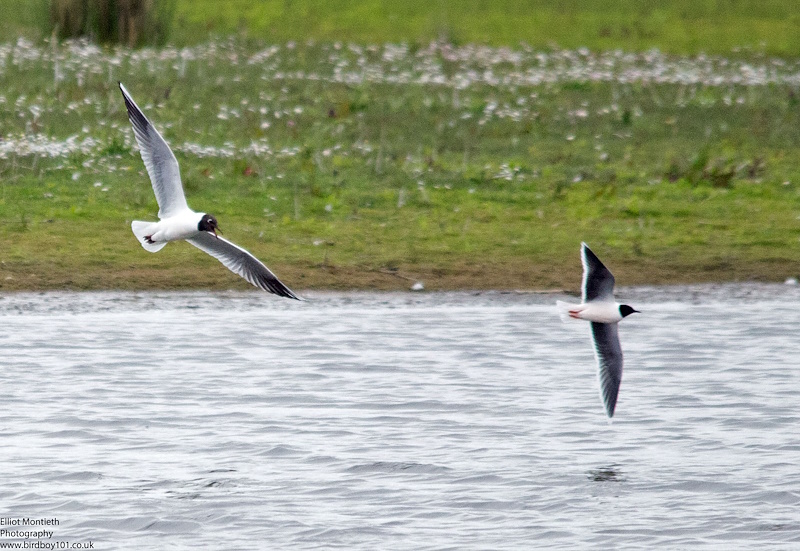
Burton Mere Wetlands May 2015
References and sources of information:
I have used records from Cheshire & Wirral Bird
Reports, Lancashire Bird Reports, Wetland Bird survey (BTO) and
BirdGuides throughout the article - for which many thanks to all.
Here is the list of References mentioned in the text:
1. T. Hedley Bell, The Birds of Cheshire, 1962.
2. T. Hedley Bell, Supplement to The Birds of
Cheshire, 1967.
3. R.A. Eades, Notes on the distribution and feeding of Little
Gulls at sea in Liverpool Bay. Seabird Rep. 6: 115-121, 1982.
4. J.D. Craggs (Editor), Hilbre - the Cheshire Island, 1982.
5. C.D. Hutchison and Brian Neath, Little Gulls in Britian and Ireland, British Birds 71, December 1978.
6. Birds of the Western Palearctic (BWP), App
edition, 2023
(NatureGuides Ltd).
7. The European Breeding Bird Atlas 2, https://ebba2.info/ (last updated 2024).
8. Birds in the European Union: a status assessment (BirdLife International, 2004).
9. Philip H. Smith, The changing status of Little Gulls Larus minitus in north Merseyside, England, SEABIRD 10, 1987.
10. Doug Messenger, Spring passage of Little Gulls across Northern England, British Birds 86, September 1993.
11. J. Lawson et al., An assessment of the numbers
and distributions of wintering waterbirds and seabirds in Liverpool Bay
area of search, JNCC, 2016.
12. Robinson, R.A., Leech, D.I. & Clark, J.A. (2023) The Online Demography Report: Bird ringing and nest recording in Britain & Ireland in 2022. BTO, Thetford (http://www.bto.org/ringing-report, created on 21-September-2023).
13. The Eurasian African Bird Migration Atlas, https://migrationatlas.org/
, 2022.
14. Clive Hartley, Little Gulls at sea off Yorkshire in autumn 2003, British birds 97, September 2004.
Richard Smith
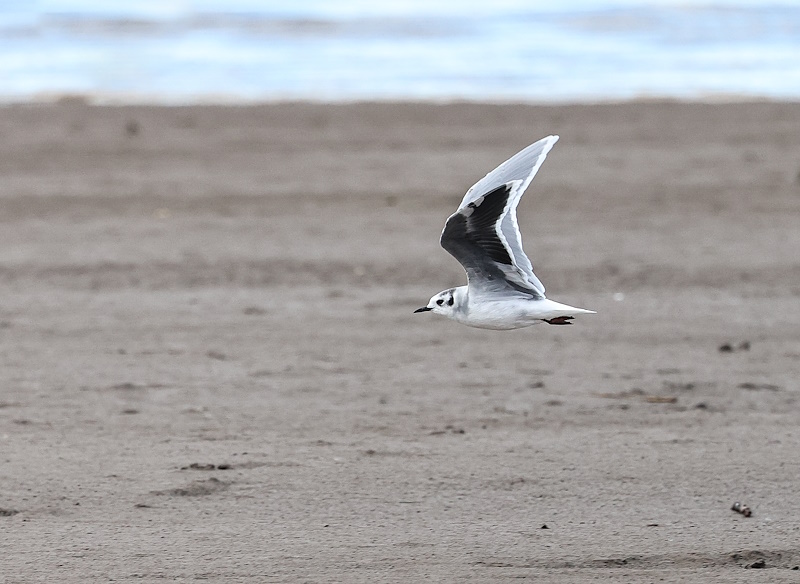
Colour Ring Report
Shelduck

Blue BL
Ringed as an adult at Martin Mere on 19/11/2018.
It was not recorded again at Martin Mere until January 2021 but since
then it has spent every winter there, usually November to March.
Recorded on Thurstaston Shore October and November 2021, March, April
and October 2022 and October 2023. It's been seen at just one other
site - Marshside in April 2023.
Latest record was on 20/04/2024 on Thurstaston Shore.
Knots

Oflag(UML)/Y
Ringed at Ardersier, Inverness, in December 2021.
It was recorded at Formby the following April before turning up at
Sandbänke Wampen, just NE of Greifswald, on the German Baltic coast in
August 2022. This is the furthest east any Orange flagged Knot, which
has also been seen on the Dee Estuary, has been recorded.
Since then it has been at Formby again, Snettisham and Heysham
(February 2024) before being seen just to the south of Little Eye on
April 20th 2024.

Oflag(PTC)/P
Ringed at Bangor Harbour in March 2024.
Recorded at Meols on April 8th 2024.

Oflag(59A)/P
Ringed at Ynyslas (Cardigan Bay) in February 2024.
Recorded at Meols on April 8th and 10th 2024.
Over 200 first winter Knots have been ringed in
Wales this last autumn and winter, including these two above. We look
forward to seeing more over the coming months.
Black-tailed Godwits

G-Oflag(JN)
Ringed at Bangor Harbour in January 2024.
Recorded at Burton Mere Wetlands four times in February and March 2024.
Recorded at Caldy on April 21st to 25th 2024.

Red (white dots) - Blue over Orange
over Yellow rings
Ringed at Moeze on the French Atlantic Coast on April 18th 2023.
Recorded at Burton Mere Wetlands on April 25th 2024.

LN-BR
Ringed in northern Iceland in July 2013.
Since being ringed this bird has been recorded 188 times!
It was first seen at Marshside in October 2013 before turning up at
Burton Mere Wetlands in March the following year.
Since then it has been recorded every year since and mostly in autumn
and spring at Gilroy NR (West Kirby), Caldy Wildfowl Collection and
Thurststason Shore.
July and August 2016 saw it at Slimbridge WWT (Gloucestshire).
Recorded at Burton Mere Wetlands on April 11th 2024.
Colour Rings were recorded by Richard
Smith, Stephen
Hinde, Richard du Feu, Mark Woodhead, Colin Schofield, and Steve
Williams.
Richard Smith
April Bird News

Westerly gales, which resulted in the tide overwhelming the new £30 million flood defence at West Kirby, and prolonged northerly winds, were not the best weather conditions for the spring migration, but despite that this April turned out to be very good.
The table below looks at the first arrival of
selected migrants, apart from the early Willow Warbler in March there
were no surprises.

The first Whinchat came through on the 11th, by the
30th there were five at Leasowe, six on Hoylake Langfields and four
just inland from Hoylake Shore.
There were a total of 23 Ring Ouzel records,
including four at Hoylake and three on Hilbre on the 6th. One, on
Hoylake Langfields, appeared to stay for around two weeks. The White
Wagtail passage was steady without being spectacular. Numbers on
Hoylake shore were low with just one count in double figures - 10 on
the 4th. The highest count was at Leasowe Lighthouse with 17 on the
24th. There were just a few Yellow Wagtails but five at Leasowe right
at the end of the month was a good count. A couple of days earlier a
'channel' Yellow Wagtail (Continental x British intermediate) caused
some excitement at the same location.

So far there have been 18 Common Redstart records this spring in
our area, always a stunning bird to see.

The list of rarities make interseting reading, if somewhat unusual. An
Iceland Gull was on Hoylake Shore on the 14th and a Sabine's Gull flew
east past Wallasey Shore the next day. On the 19th four Common Cranes
flew over Burton Mere Wetlands before alighting on Burton Marsh, then
flew towards New Brighton. Next two White Storks also flew over Burton
Mere Wetlands on the 27th, they were seen again on the 30th by which
time a third had joined them.


The first Whimbrels started to come through on the
14th. They were fairly widespread in fields as well as on the shore,
max count was 157 on Heswall Shore on the 26th. There were some
stunning looking waders in summer plumage including Grey Plovers,
Black-tailed Godwits and these Knots, above.
Knots stage in Iceland on their way to Greenland and
Canada, and Whimbrels breed in Iceland in large numbers, as do these
Pink-footed Geese which left us through the month, including 6,000
which flew out of the estuary on the 20th.
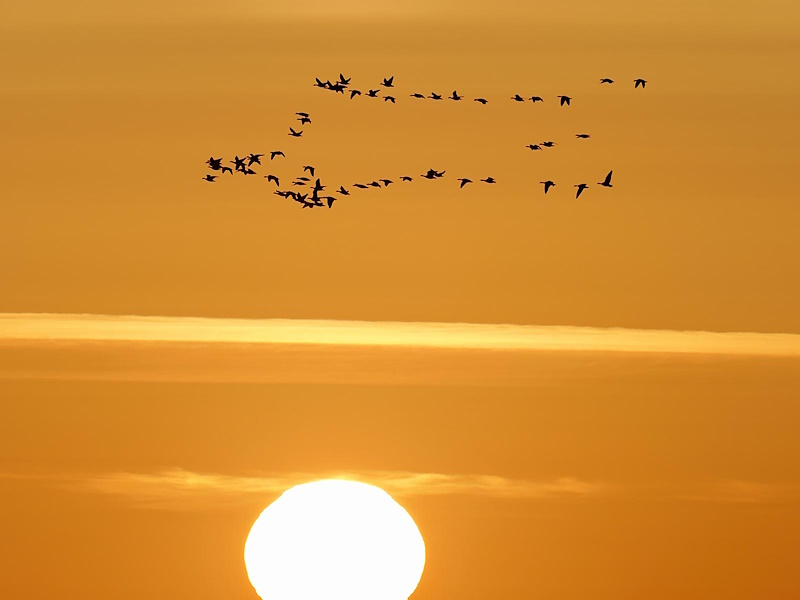
What to expect in May
Spring migration will still be well underway this month. The last
regular migrant to arrive here is the Spotted Flycatcher, and they
usually peak around the third week in May. There should also be
Whinchats coming through and we sometimes see them in double figures
with the sheep pens by the Burton Point path and the Leasowe Lighthouse
area being favourite spots. Wood Warblers are now very scarce but we
usually see, and hear, one or two.
Whimbrel numbers at Heswall will peak early May and we could get over 200 there. Other waders will include Ringed Plovers, Sanderlings and Dunlins. The beaches at Point of Ayr and Hoylake is the best place to see them These are not ones which have spent the winter here, they will be flying up from Africa. A rarer wader to look out for is the Curlew Sandpiper, most migrate much further east on their way from central and southern Africa to breed in the far north of Siberia, but most springs we get one or two adults in full breeding plumage feeding up before the long flight north-east.
May can be an excellent month for rarities and over
the past few years these have included Puffins, Black-winged Stilt,
Hoopoe and Bonaparte's Gull.
Forthcoming Events
May Highest Spring Tides (Liverpool)
Also see Tides page.
8th May, 11.55hrs (BST), 9.9m.
9th May, 12.39hrs (BST), 9.7m.
Forthcoming Events
Also see events at https://events.rspb.org.uk/deeestuary